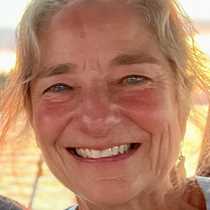Los Cabos
After a very calm night traveling south, we awoke this morning near the tip of the Baja peninsula. The intention had been to sleep in, but humpback whales were sighted at 7 am, so our expedition leader gently encouraged us to step outside... in our pajamas. We watched them in the early morning quiet, and then continued on our way. Other humpback whales swam and dove within view of the ship.
As the morning wore on and we awoke more fully, our marine mammal sightings grew livelier as well. Bottlenose dolphins approached and rode the bow wave. We leaned over the forward rail, and looked straight down on their blowholes as they opened and closed them with each breath. The underwater bow camera gave a completely different view. Mounted on the hull, it showed the dolphins’ "free ride" as they effortlessly swam from the ship’s pressure wave. Bowriding dolphins do not move their tail flukes and seem to swim with effortless grace.
When we came across humpback whales again, there were nine of them. Most of the whales were chasing each other in what biologists call a competitive group. They charged along like freight trains, with great energy and force, just below the water’s surface. We were completely surprised when another humpback breached close to the ship! The whale breached repeatedly, then rolled onto its back and slapped its enormous pectoral flippers on the water’s surface.
When we finally left the whales, we went below for some presentations: Gretchen gave an illustrated presentation on the adaptations of desert plants, and Berit showed yesterday’s underwater video of swimming sea lions, and some colorful and incredibly well-camouflaged fishes at Los Islotes.
Cabo San Lucas was a shocking change from the unspoiled, open air and wildlife of our previous days. Tourist boats, sport fishing boats, hotels, construction and cranes filled the harbor and lined the waterfront. We traveled by coach to San Jose del Cabo, a quieter Mexican town compared to the bustling, touristy feel of Cabo San Lucas. We looked for birds along an estuary, and found more than 45 species today. Many of us also walked into town, and enjoyed the shops, galleries and refreshing drinks offered by San Jose del Cabo.
After returning to the ship, we said goodbye to Los Cabos with a final stop: Friars Rocks, the dramatic, granitic rocks which separate the Gulf of California from the Pacific Ocean. We looked through the famous rock arch, sipped rum punch, listened to sea lions, and looked for sea birds. As the sun dipped behind distant fog, a glimmer of green was visible at the sun’s rim... the green flash!
After a very calm night traveling south, we awoke this morning near the tip of the Baja peninsula. The intention had been to sleep in, but humpback whales were sighted at 7 am, so our expedition leader gently encouraged us to step outside... in our pajamas. We watched them in the early morning quiet, and then continued on our way. Other humpback whales swam and dove within view of the ship.
As the morning wore on and we awoke more fully, our marine mammal sightings grew livelier as well. Bottlenose dolphins approached and rode the bow wave. We leaned over the forward rail, and looked straight down on their blowholes as they opened and closed them with each breath. The underwater bow camera gave a completely different view. Mounted on the hull, it showed the dolphins’ "free ride" as they effortlessly swam from the ship’s pressure wave. Bowriding dolphins do not move their tail flukes and seem to swim with effortless grace.
When we came across humpback whales again, there were nine of them. Most of the whales were chasing each other in what biologists call a competitive group. They charged along like freight trains, with great energy and force, just below the water’s surface. We were completely surprised when another humpback breached close to the ship! The whale breached repeatedly, then rolled onto its back and slapped its enormous pectoral flippers on the water’s surface.
When we finally left the whales, we went below for some presentations: Gretchen gave an illustrated presentation on the adaptations of desert plants, and Berit showed yesterday’s underwater video of swimming sea lions, and some colorful and incredibly well-camouflaged fishes at Los Islotes.
Cabo San Lucas was a shocking change from the unspoiled, open air and wildlife of our previous days. Tourist boats, sport fishing boats, hotels, construction and cranes filled the harbor and lined the waterfront. We traveled by coach to San Jose del Cabo, a quieter Mexican town compared to the bustling, touristy feel of Cabo San Lucas. We looked for birds along an estuary, and found more than 45 species today. Many of us also walked into town, and enjoyed the shops, galleries and refreshing drinks offered by San Jose del Cabo.
After returning to the ship, we said goodbye to Los Cabos with a final stop: Friars Rocks, the dramatic, granitic rocks which separate the Gulf of California from the Pacific Ocean. We looked through the famous rock arch, sipped rum punch, listened to sea lions, and looked for sea birds. As the sun dipped behind distant fog, a glimmer of green was visible at the sun’s rim... the green flash!



